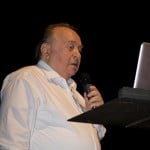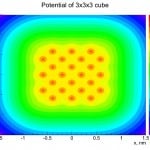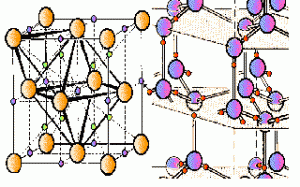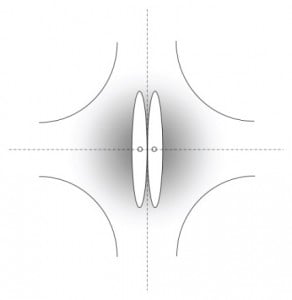 Update 01/2013 —Registration of Energy Discharge in D+D→4He* Reaction in Conducting Crystals (Simulation of Experiment) [.pdf] by Edward Tsyganov from Proceedings of Channeling 2012 Conference in Alghero, Sardinia, Italy.
Update 01/2013 —Registration of Energy Discharge in D+D→4He* Reaction in Conducting Crystals (Simulation of Experiment) [.pdf] by Edward Tsyganov from Proceedings of Channeling 2012 Conference in Alghero, Sardinia, Italy.
 In my point of view, series of the experiments in Gran Sasso Laboratory under leadership of Dr. Claus Rolfs and similar experiments in Berlin by Dr. K. Czerski and colleagues during 2002-2009 show unusually high electron screening potential in metallic crystals. These experimental facts give a good mechanism how the Coulomb barrier overcame with low energy (thermal) deuterons.
In my point of view, series of the experiments in Gran Sasso Laboratory under leadership of Dr. Claus Rolfs and similar experiments in Berlin by Dr. K. Czerski and colleagues during 2002-2009 show unusually high electron screening potential in metallic crystals. These experimental facts give a good mechanism how the Coulomb barrier overcame with low energy (thermal) deuterons.
[latexpage]
“The circumstances of hot fusion are not the circumstances of cold fusion”, wrote Julian Schwinger, co-Nobel-prize winner with Richard Feynmann and Shinichiro Tomonaga in 1965 for their work on quantum electro-dynamics (QED).
But there is no shortage of hot fusion analysis of cold fusion. Might some ideas be applicable?
Edward Tsyganov believes so.
Dr. Tsyganov is a professor at University of Texas Southwestern Medical Center who specializes in nuclear detectors, but in 1975, Tsyganov was part of an international group working on the Tevatron proton accelerator at Fermilab, just after successfully completing the first Russian-American scientific collaboration on the Serpukhov 70 GeV proton accelerator in Russia.
Muon catalysis had been discovered by Professor Luis Alvarez, whom he met at Lawrence Berkeley Lab in 1976. Although exciting, muon catalytic fusion did not look very promising to Tsyganov due to the short life time span of the muon.
Later, in December 1989, he was sitting in the audience of a seminar with Martin Fleischmann at CERN in Geneva, Switzerland, having participated in the DELPHI experiment at the Large Electron Positron collider. [visit] He was very excited with Fleischmann’s presentation but, at the time, he had just introduced bent crystals for beam deflection, now used in high-energy physics. The study of crystalline structures drew him away from cold fusion research, which he had heard was “a false observation” anyway.

Scientists there have shown that when a deuterium atom is embedded in a metallic crystal, the cross section, which gives a measure of the probability that a fusion reaction will occur, increases in comparison with that of free atoms.
In the 2002-2008 series of international low-energy accelerator experiments, low-energy deuterium beams directed at embedded deuterium atoms showed that, in this environment, the screening potential for the orbital electrons of the embedded atoms is substantially increased. This means that in such conditions, any supplemental embedded nuclei in a single host crystal cell could sit much closer than they normally would due to the Coulomb repulsion.
Can this idea be applied to the low-energy nuclear reaction (LENR) in a solid?
The problem of overcoming the Coulomb barrier, the powerful force that keeps positively-charged protons away from each other, is the central issue for developing clean cold fusion energy. The force that holds nuclei together is called the strong nuclear force. Though it is an extremely powerful force, it only extends for a small distance. Unless nuclei can get close enough for the strong force to take effect, positively-charged nuclei remain too far away from each other to fuse. Elements other than hydrogen have an even bigger Coulomb barrier, since they have many more protons, and a stronger positive-charge. This is true for both free particles, and those housed in a solid metal.

In this environment, deuterons or other nuclei may sit closer together in one host crystalline cell than they normally would. In a paper Cold Nuclear Fusion [1], Tsyganov cites data obtained by Francesco Raiola et al, for the screening Assenbaum potential for deuterium embedded in platinum as 675 +/- 50 eV, which is around 25 times larger than for free atoms of deuterium.
“The so-called screening Assenbaum potential is usually considered as an additional energy of interaction in a fusion process, and this effective energy should be used for calculations,” writes Tsyganov.
“This means that atoms of deuterium embedded in a metallic crystal do not feel the Coulomb repulsion down to distances of 25 times smaller than the size of the free deuterium atoms, increasing the probability of barrier penetration.”
“It was evident that in such conditions two deuteron atoms could approach each other to the distance of 1/10 – 1/20 of the size of an undistorted atom, without feeling the Coulomb repulsion.”
“Normally at very low energies for the deuterium molecule, the Coulomb barrier permeability for deuterium atoms is of the order of $10^{-84}$, including the Assenbaum screening potential (27 eV). However, in an environment of a single metallic crystalline cell this value jumps by $10^{50}$ – $10^{60}$ times! At the same time the real kinetic energy of the interacting deuterium atoms is still very low, some tiny fraction of an eV. All the enhancement of Coulomb barrier permeability is due to much shorter distance between the interacting deuterium nuclei.”

For Tsyganov, this illustrates the difference between hot fusion and cold fusion.
“Hot fusion produces compound nuclei through multiple single encounters of the particles. In cold fusion, particles interact with the same partner through the quantum oscillations in a ‘closed box…'”, he writes. “This oscillation frequency is directly proportional to the screening potential, or box “size”, giving an additional boost to the process.”
Suppose that two deuterium atoms are trapped inside a single crystalline cell of palladium. The electrons associated with the deuterium will have an elongated shape in response to the cloud of conduction electrons, their orbits distorted by the catalytic effect. This is what allows the deuterium nuclei to situate themselves only a fraction of the distance they would normally tolerate.
 Together, these two atoms make a “quasi-molecule” that oscillates at a particular frequency. While Tsyganov admits that calculating the particular oscillation frequency of a deuterium quasi-molecule in the midst of so many potential fields inside the crystal is difficult, he uses Planck’s relation as an approximation to give a frequency $\nu = E/h$, where $E$ is the experimentally measured screening potential and $h$ is Planck’s constant.
Together, these two atoms make a “quasi-molecule” that oscillates at a particular frequency. While Tsyganov admits that calculating the particular oscillation frequency of a deuterium quasi-molecule in the midst of so many potential fields inside the crystal is difficult, he uses Planck’s relation as an approximation to give a frequency $\nu = E/h$, where $E$ is the experimentally measured screening potential and $h$ is Planck’s constant.
For deuterium embedded in a platinum metallic crystal, the screening potential was measured by Raiola as about 675 eV. This gives a vibrational frequency for the quasi-molecule as $1.67 \hspace{1 mm}\text{x}\hspace{1 mm} 10^{17}$ per second, and offers an estimate of the number of times the nuclei get close enough to fuse.
Multiplying this value for the oscillation frequency by the barrier permeability, a measure of the ability to overcome the Coulomb repulsion, of $2.52 \hspace{1 mm}\text{x}\hspace{1 mm} 10^{-17}$ yields a rate of 4.21 Deuterium-Dueterium fusion events per second.

“I took this observation and applied these enlarged screening potential to the condition of McKubre experiments with deuterated palladium”, says Tsyganov.[1] “Heat release of Michael McKubre and the SRI team is well explained. In fact, this is the first confirmation of the cold fusion process using independent data from accelerators.”
Tsyganov believes experiments of Yoshiaki Arata and similar experiments of Mitchell Swartz could be also explained with this mechanism, if “quantitative data on deuterium contamination in palladium nano-crystals would be available.” He is convinced that the mechanism in McKubre’s experiments and that of Arata and Swartz’ are the same.
“Experiments of Francesco Piantelli and Andrea Rossi are well fitted in the above model. Higher heat release in the Rossi case is probably explainable by the use of platinum catalyst”, writes Tsyganov.
“Professor S.B. Dabagov, Professor M.D. Bavizhev and I have tried to analyze the nuclear processes occurring in the Ecat installation and provide a possible explanation for the observed results, says Tsyganov. “In addition to the slowing of the nuclear decay processes of the intermediate compound nucleus formed during the cold fusion of elements [2], some modification of the decay process of the intermediate nucleus of the compound (H+Ni)* must be assumed to provide a plausible explanation of the Rossi results. We discuss such possibilities in this paper.”
Tsyganov’s idea pertains to how nuclei might become situated close enough inside a metal to overcome the Coulomb barrier and fuse, an idea derived from hot-fusion experiments. Still, he believes this model can be applied to the cold fusion environment too, claiming predictions agree well with heat energy measured by SRI and extend to the nickel-hydrogen systems as well.
I asked Dr. Tsyganov how his model might explain some other experimental data in cold fusion.

Q&A with Edward Tsyganov
CFN Supposing two deuterium can fuse in this way, how would the heat be dissipated through the lattice?
Tsyganov There is the traditional belief among nuclear scientists that nothing in a nucleus could depend on the outside world. It is very true for the fast processes in a nucleus (and these processes usually are very fast due to the very small size of a nucleus) because it is necessary that some time pass to reach the outside world. This time is about $10^{-19}$ seconds and is defined by the size of atom and speed of light.
However, according to the only hypothesis of mine, the intermediate compound nucleus 4He* created in cold DD fusion, as also in other cold fusion cases, presents an absolutely unique situation. After the penetration of main Coulomb barrier (about 200 keV high), deuterons save their identities for some time, due to the residual Coulomb mini-barrier, already inside the strong potential well. This mini-barrier very much reduced and smothered by the strong interaction forces (quark-gluon mechanism) and the finite sizes of the deuterons, but still prevents immediate nucleonic exchange between the two deuterons.

I would highlight again that the decrease of nuclear decay rate at the very low excitation energy is the only hypothesis in all my consideration.
This situation could be treated as the experimental evidence. High electron screening potentials makes the cold fusion process the must. At the same time there are no neutrons and other nuclear products detected experimentally. An explanation must be provided. The only explanation (and the very reasonable one) that I could think of is the decrease of nuclear decay rate with decreasing of the energy of excitation.
If one adopts this hypothesis, further explanation does not presents real difficulties. Quantum electrodynamics provides the framework, through exchange by the virtual photons. Julian Swinger was very close to this solution but did not make the final step. Energy of discharge 4He* to the ground state 4He is released mostly by several hundreds of low energy electrons, with very short range in the crystal. About 400 60 keV electrons produce the heat.
CFN How might the production of tritium be explained with this process?
Tsyganov Production of tritium in McKubre’s experiments could be explained, if the nuclear decay rate of 4He* in cold fusion is reduced, but still non-negligible. This rate is at least two orders of magnitude less than expected for hot fusion. Perhaps, cracks and defects of the palladium sample could also contribute. I hope this question could soon be answered in future studies.
CFN Thank you Dr. Tsyganov.
Tsyganov My pleasure.
[1] Cold Nuclear Fusion by E.N. Tsyganov published Physics of Atomic Nuclei 2012, Vol. 75, No. 2, pp. 153–159 [.pdf]
[2] Cold Fusion Continues by E.N. Tsyganov, S.B. Dabagov, and M.D. Bavizhev, from the Proceedings of “Solid State Chemistry: Nano-materials and Nanotechnology” Conference, 22-27 April, 2012, Stavropol, Russia Report in Stavropol 4-24-2012 [.pdf]
[3] Cold Nuclear Fusion by E.N. Tsyganov on Journal of Nuclear Physics [visit]
